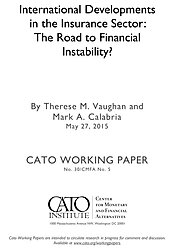Notes:
1 Harrington (2009) provides a detailed discussion of the role played by AIG in the 2007–2009 financial crisis. The Office of Thrift Supervision (OTS) was AIG’s consolidated holding company regulator, while state insurance regulators regulated AIG’s subsidiary insurance companies. When AIG faced a severe liquidity crisis, the U.S. Treasury and Federal Reserve stepped in with funding, most of which “was paid to banking and investment banking organizations, including large amounts to foreign banks, especially E.U. institutions.” Because the banks were not required to take haircuts on amounts owed to them, some observers have characterized the AIG transactions as a “back-door bank bailout.” According to federal policymakers, the Federal Reserve could not require foreign banks to take haircuts, and thus made the decision to forego haircuts on payments to U.S. banks, with the goal of treating domestic and foreign banks equally. (See,for example, Shenn et al. 2010 and Sanati 2009). State insurance regulators have stated that insurance companies had sufficient funds to pay policyholder claims, and that the bailout was not necessary to protect insurance policyholders.
2 Chen et al. (2013) find that insurers are victims rather than instigators of systemic risk. Cummins and Weiss (2013) analyze the insurance industry against a number of systemic risk indicators and conclude that the core activities of insurers are not a significant source of systemic risk, but that banking functions such as derivatives trading are a potential source. IAIS (2012) concluded that insurers engaged in traditional insurance activities were largely not a concern from a systemic perspective.
International Developments in the Insurance Sector: The Road to Financial Instability?
International activity related to the regulation and supervision of financial services has exploded since the global financial crisis. The crisis exposed weaknesses in the structure for regulating internationally active banks, and motivated a number of work streams aimed at strengthening standards (most notably, significant revisions to the Basel capital standard for internationally active banks, now known as Basel III). The insurance sector was also stressed by the meltdown in financial markets that occurred in 2007–2008, albeit far less than the banking sector, and, with the exception of AIG, it is generally recognized that insurers played little role in the financial crisis, and that traditional insurance activities do not pose a systemic risk to the financial system.1,2 Nonetheless, the insurance sector has also been targeted for a new stream of regulatory initiatives at the international level. The most important organizations with respect to these activities are the International Association of Insurance Supervisors (IAIS) and the Financial Stability Board (FSB), both based in Basel, Switzerland. The purpose of this paper is to review these developments and to highlight potential concerns for U.S. insurance markets.
